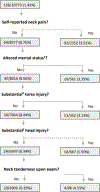PECARN prediction rule for cervical spine imaging of children presenting to the emergency department with blunt trauma: a multicentre prospective observational study
- PMID: 38843852
- PMCID: PMC11261431
- DOI: 10.1016/S2352-4642(24)00104-4
PECARN prediction rule for cervical spine imaging of children presenting to the emergency department with blunt trauma: a multicentre prospective observational study
Erratum in
-
Correction to Lancet Child Adolesc Health 2024; 8: 482-90.Lancet Child Adolesc Health. 2024 Dec;8(12):e17. doi: 10.1016/S2352-4642(24)00311-0. Lancet Child Adolesc Health. 2024. PMID: 39572126 No abstract available.
Abstract
Background: Cervical spine injuries in children are uncommon but potentially devastating; however, indiscriminate neck imaging after trauma unnecessarily exposes children to ionising radiation. The aim of this study was to derive and validate a paediatric clinical prediction rule that can be incorporated into an algorithm to guide radiographic screening for cervical spine injury among children in the emergency department.
Methods: In this prospective observational cohort study, we screened children aged 0-17 years presenting with known or suspected blunt trauma at 18 specialised children's emergency departments in hospitals in the USA affiliated with the Pediatric Emergency Care Applied Research Network (PECARN). Injured children were eligible for enrolment into derivation or validation cohorts by fulfilling one of the following criteria: transported from the scene of injury to the emergency department by emergency medical services; evaluated by a trauma team; and undergone neck imaging for concern for cervical spine injury either at or before arriving at the PECARN-affiliated emergency department. Children presenting with solely penetrating trauma were excluded. Before viewing an enrolled child's neck imaging results, the attending emergency department clinician completed a clinical examination and prospectively documented cervical spine injury risk factors in an electronic questionnaire. Cervical spine injuries were determined by imaging reports and telephone follow-up with guardians within 21-28 days of the emergency room encounter, and cervical spine injury was confirmed by a paediatric neurosurgeon. Factors associated with a high risk of cervical spine injury (>10%) were identified by bivariable Poisson regression with robust error estimates, and factors associated with non-negligible risk were identified by classification and regression tree (CART) analysis. Variables were combined in the cervical spine injury prediction rule. The primary outcome of interest was cervical spine injury within 28 days of initial trauma warranting inpatient observation or surgical intervention. Rule performance measures were calculated for both derivation and validation cohorts. A clinical care algorithm for determining which risk factors warrant radiographic screening for cervical spine injury after blunt trauma was applied to the study population to estimate the potential effect on reducing CT and x-ray use in the paediatric emergency department. This study is registered with ClinicalTrials.gov, NCT05049330.
Findings: Nine emergency departments participated in the derivation cohort, and nine participated in the validation cohort. In total, 22 430 children presenting with known or suspected blunt trauma were enrolled (11 857 children in the derivation cohort; 10 573 in the validation cohort). 433 (1·9%) of the total population had confirmed cervical spine injuries. The following factors were associated with a high risk of cervical spine injury: altered mental status (Glasgow Coma Scale [GCS] score of 3-8 or unresponsive on the Alert, Verbal, Pain, Unresponsive scale [AVPU] of consciousness); abnormal airway, breathing, or circulation findings; and focal neurological deficits including paresthesia, numbness, or weakness. Of 928 in the derivation cohort presenting with at least one of these risk factors, 118 (12·7%) had cervical spine injury (risk ratio 8·9 [95% CI 7·1-11·2]). The following factors were associated with non-negligible risk of cervical spine injury by CART analysis: neck pain; altered mental status (GCS score of 9-14; verbal or pain on the AVPU; or other signs of altered mental status); substantial head injury; substantial torso injury; and midline neck tenderness. The high-risk and CART-derived factors combined and applied to the validation cohort performed with 94·3% (95% CI 90·7-97·9) sensitivity, 60·4% (59·4-61·3) specificity, and 99·9% (99·8-100·0) negative predictive value. Had the algorithm been applied to all participants to guide the use of imaging, we estimated the number of children having CT might have decreased from 3856 (17·2%) to 1549 (6·9%) of 22 430 children without increasing the number of children getting plain x-rays.
Interpretation: Incorporated into a clinical algorithm, the cervical spine injury prediction rule showed strong potential for aiding clinicians in determining which children arriving in the emergency department after blunt trauma should undergo radiographic neck imaging for potential cervical spine injury. Implementation of the clinical algorithm could decrease use of unnecessary radiographic testing in the emergency department and eliminate high-risk radiation exposure. Future work should validate the prediction rule and care algorithm in more general settings such as community emergency departments.
Funding: The Eunice Kennedy Shriver National Institute of Child Health and Human Development and the Health Resources and Services Administration of the US Department of Health and Human Services in the Maternal and Child Health Bureau under the Emergency Medical Services for Children programme.
Copyright © 2024 Elsevier Ltd. All rights reserved, including those for text and data mining, AI training, and similar technologies.
Conflict of interest statement
Declaration of interests We declare no competing interests.
Figures


References
-
- Viccellio P, Simon H, Pressman BD, Shah MN, Mower WR, Hoffman JR. A prospective multicenter study of cervical spine injury in children. Pediatrics 2001; 108(2): E20. - PubMed
-
- Platzer P, Jaindl M, Thalhammer G, et al. Cervical spine injuries in pediatric patients. J Trauma 2007; 62(2): 389–96; discussion 94–6. - PubMed
-
- Broder J, Fordham LA, Warshauer DM. Increasing utilization of computed tomography in the pediatric emergency department, 2000–2006. Emerg Radiol 2007; 14(4): 227–32. - PubMed
Publication types
MeSH terms
Associated data
Grants and funding
LinkOut - more resources
Full Text Sources
Medical

